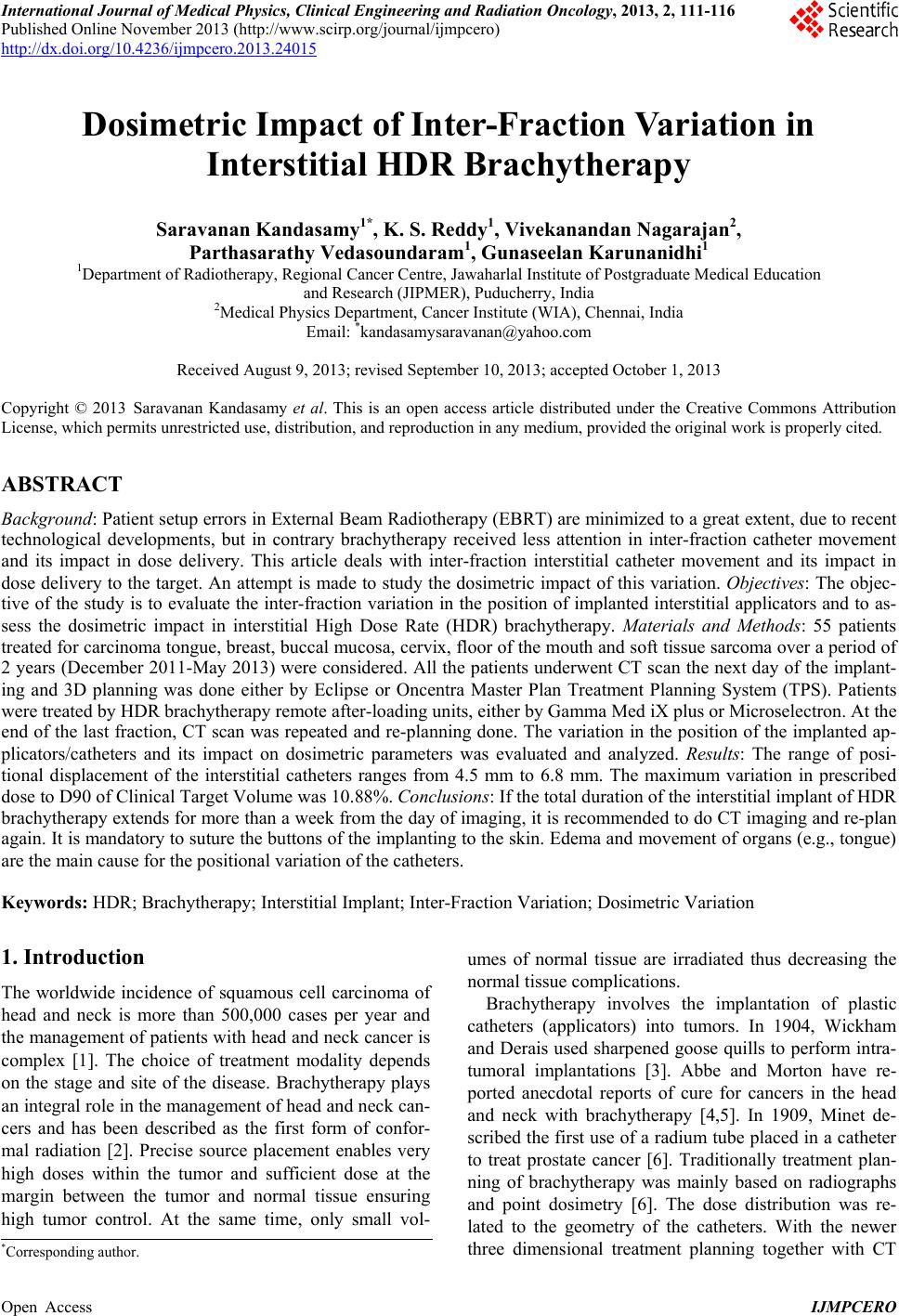
International Journal of Medical Physics, Clinical Engineering and Radiation Oncology, 2013, 2, 111-116
Published Online November 2013 (http://www.scirp.org/journal/ijmpcero)
http://dx.doi.org/10.4236/ijmpcero.2013.24015
Open Access IJMPCERO
Dosimetric Impact of Inter-Fraction Variation in
Interstitial HDR Brachytherapy
Saravanan Kandasam y1*, K. S. Reddy1, Vivekanandan Nagarajan2,
Parthasarathy Vedasoundaram1, Gunaseelan Karunanidhi1
1Department of Radiotherapy, Regional Cancer Centre, Jawaharlal Institute of Postgraduate Medical Education
and Research (JIPMER), Puducherry, India
2Medical Physics Department, Cancer Institute (WIA), Chennai, India
Email: *kandasamysaravanan@yahoo.com
Received August 9, 2013; revised September 10, 2013; accepted October 1, 2013
Copyright © 2013 Saravanan Kandasamy et al. This is an open access article distributed under the Creative Commons Attribution
License, which permits unrestricted use, distribution, and reproduction in any medium, provided the original work is properly cited.
ABSTRACT
Background: Patient setup errors in External Beam Radiotherapy (EBRT) are minimized to a great extent, due to recent
technological developments, but in contrary brachytherapy received less attention in inter-fraction catheter movement
and its impact in dose delivery. This article deals with inter-fraction interstitial catheter movement and its impact in
dose delivery to the target. An attempt is made to study the dosimetric impact of this variation. Objectives: The objec-
tive of the study is to evaluate the inter-fraction variation in the position of implanted interstitial applicators and to as-
sess the dosimetric impact in interstitial High Dose Rate (HDR) brachytherapy. Materials and Methods: 55 patients
treated for carcinoma tongue, breast, buccal mucosa, cervix, floor of the mouth and soft tissue sarcoma over a period of
2 years (December 2011-May 2013) were considered. All the patients underwent CT scan the next day of the implant-
ing and 3D planning was done either by Eclipse or Oncentra Master Plan Treatment Planning System (TPS). Patients
were treated by HDR brachytherapy remote after-loading units, either by Gamma Med iX plus or Microselectron. At the
end of the last fraction, CT scan was repeated and re-planning done. The variation in the position of the implanted ap-
plicators/catheters and its impact on dosimetric parameters was evaluated and analyzed. Results: The range of posi-
tional displacement of the interstitial catheters ranges from 4.5 mm to 6.8 mm. The maximum variation in prescribed
dose to D90 of Clinical Target Volume was 10.88%. Conclusions: If the total duration of the interstitial implant of HDR
brachytherapy extends for more than a week from the day of imaging, it is recommended to do CT imaging and re-plan
again. It is mandatory to suture the buttons of the implanting to the skin. Edema and movement of organs (e.g., tongue)
are the main cause for the positional variation of the catheters.
Keywords: HDR; Brachytherapy; Interstitial Implant; Inter-Fraction Variation; Dosimetric Variation
1. Introduction
The worldwide incidence of squamous cell carcinoma of
head and neck is more than 500,000 cases per year and
the management of patients with head and neck cancer is
complex [1]. The choice of treatment modality depends
on the stage and site of the disease. Brachytherapy plays
an integral role in the management of head and neck can-
cers and has been described as the first form of confor-
mal radiation [2]. Precise source placement enables very
high doses within the tumor and sufficient dose at the
margin between the tumor and normal tissue ensuring
high tumor control. At the same time, only small vol-
umes of normal tissue are irradiated thus decreasing the
normal tissue complications.
Brachytherapy involves the implantation of plastic
catheters (applicators) into tumors. In 1904, Wickham
and Derais used sharpened goose quills to perform intra-
tumoral implantations [3]. Abbe and Morton have re-
ported anecdotal reports of cure for cancers in the head
and neck with brachytherapy [4,5]. In 1909, Minet de-
scribed the first use of a radium tube placed in a catheter
to treat prostate cancer [6]. Traditionally treatment plan-
ning of brachytherapy was mainly based on radiographs
and point dosimetry [6]. The dose distribution was re-
lated to the geometry of the catheters. With the newer
three dimensional treatment planning together with CT
*Corresponding author.